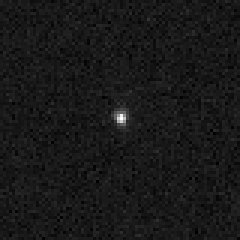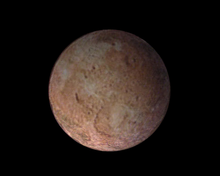(90377) Sedna
 Zdjęcie Sedny z Kosmicznego Teleskopu Hubble’a | |
| Odkrywca | |
|---|---|
| Data odkrycia | 14 listopada 2003[1] |
| Numer kolejny | 90377 |
| Oznaczenie tymczasowe | 2003 VB12 |
| Charakterystyka orbity (2022-08-09) | |
| Przynależność obiektu | TNO[1], obiekt odłączony lub wewnętrzna część Obłoku Oorta |
| Półoś wielka | |
| Mimośród | 0,8535[1] |
| Peryhelium | |
| Aphelium | |
| Okres obiegu wokół Słońca | 11 900 ± 6[1] lat |
| Średnia prędkość | ok. 1,0 km/s |
| Inklinacja | 11,93[1]° |
| Charakterystyka fizyczna | |
| Średnica | model termofizyczny: |
| Okres obrotu | |
| Albedo | 0,32 ± 0,06[2] |
| Jasność absolutna | |
| Średnia temperatura powierzchni | |
(90377) Sedna (symbol: ![]() )[4] – duża planetoida transneptunowa, poruszająca się po bardzo wydłużonej orbicie.
)[4] – duża planetoida transneptunowa, poruszająca się po bardzo wydłużonej orbicie.
Odkrycie i nazwa
Planetoida ta została odkryta 14 listopada 2003 przez Mike’a Browna, Chada Trujillo oraz Davida Rabinowitza, z California Institute of Technology, za pomocą 120-centymetrowego teleskopu Samuela Oschina, znajdującego się w Obserwatorium Palomar niedaleko San Diego. Odkrycia dokonano w ramach prowadzonego od jesieni 2001 przeglądu zewnętrznych rejonów Układu Słonecznego. Odkrycie zostało zweryfikowane przez amatorskie obserwatorium Tenagra w Arizonie[5]. Planetoida ta obserwowana była również przez Kosmiczny Teleskop Hubble’a.
Otrzymała ona najpierw oznaczenie prowizoryczne 2003 VB12.
Obiekt nazwany został imieniem Sedny, mitologicznej bogini mórz w wierzeniach Inuitów – ludów zamieszkujących rejony arktyczne, od Grenlandii po Czukotkę w Rosji[3].
Orbita
Orbita Sedny nachylona jest do płaszczyzny ekliptyki pod kątem 11,93°. Na jeden obieg wokół Słońca potrzebuje ok. 11 900 lat. Krąży w średniej odległości ok. 521 au, po mocno wydłużonej eliptycznej orbicie o mimośrodzie około 0,85. Średnia prędkość orbitalna tej planetoidy to ok. 1,0 km/s.
W momencie odkrycia znajdowała się w odległości 90 au i tym samym okazała się najdalszym[a] obserwowanym obiektem w Układzie Słonecznym. Obecnie Sedna zbliża się do Słońca i w 2075 roku[1] osiągnie peryhelium, znajdując się wtedy w odległości 76 au od Słońca (ponad dwa razy dalej niż Pluton). Następnie przez około 5950 lat będzie się oddalać, aż osiągnie aphelium w odległości ok. 966 au od Słońca (ok. 19,5 razy dalej niż Pluton).
Jest określana jako obiekt odłączony nowej klasy sednoid[6] lub nawet wchodzący w skład wewnętrznej części obłoku Oorta.
Właściwości fizyczne
Sedna ma średnicę szacowaną na ok. 995 km. Jej albedo wynosi ok. 0,32[6], a jasność absolutna to 1,54m[1]. Sedna jest prawdopodobnie bardzo zimnym obiektem; temperaturę jej powierzchni oszacowano na około –240 do –261 °C (12–33 K)[3]. Naukowcy przypuszczają, że składa się ona ze skał i lodu.
Sedna jest prawdopodobnie pierwszym odkrytym obiektem z wewnętrznej części Obłoku Oorta i zarazem pierwszym bezpośrednim dowodem jego istnienia. Jest to drugi po Marsie najczerwieńszy obiekt w naszym Systemie. Sedna jest jednym z niewielu tak dużych obiektów odkrytych w Układzie Słonecznym od 1930 roku, kiedy to po raz pierwszy zaobserwowano Plutona.
Sedna może zostać uznana w przyszłości za planetę karłowatą i plutoid.
Zobacz też
Uwagi
- ↑ W 2005 roku odkryto Eris, która obecnie znajduje się dalej od Słońca niż Sedna. Zobacz też: 2012 VP113 i V774104.
Przypisy
- ↑ a b c d e f g h i j k l m (90377) Sedna w bazie Jet Propulsion Laboratory (ang.) [data dostępu: 2022-06-28]
- ↑ a b A. Pál, C. Kiss, T.G. Müller, P. Santos-Sanz i inni. "TNOs are Cool": A survey of the trans-Neptunian region. VII. Size and surface characteristics of (90377) Sedna and 2010 EK139. „Astronomy & Astrophysics”. 541, s. L6, 2012. DOI: 10.1051/0004-6361/201218874. arXiv:1204.0899. Bibcode: 2012A&A...541L...6P.
- ↑ a b c Krzysztof Czart: Kosmos. Poznań: Oxford Educational, 2011, s. 24. 15. ISBN 978-83-252-1366-4.
- ↑ U+2BF2 ⯲. David Faulks (2016) 'Eris and Sedna Symbols,' L2/16-173R, Unicode Technical Committee Document Register.
- ↑ Mike Brown: Sedna (2003 VB12) (ang.). [dostęp 2016-06-06].
- ↑ a b Wm. Robert Johnston: List of Known Trans-Neptunian Objects (ang.). Johnston’s Archive, 2022-01-02. [dostęp 2022-06-28].
Bibliografia
- (90377) Sedna w bazie Jet Propulsion Laboratory (ang.)
- (90377) Sedna w bazie Minor Planet Center (ang.)
Linki zewnętrzne
- Diagram orbity (90377) Sedna w bazie Jet Propulsion Laboratory (ang.)
- Mike Brown: Sedna (2003 VB12) (ang.). [dostęp 2020-12-20].
Media użyte na tej stronie
This is a revised version of Solar_System_XXIX.png.
These three panels show the first detection of the faint distant object dubbed "Sedna." Imaged on November 14th from 6:32 to 9:38 Universal Time, Sedna was identified by the slight shift in position noted in these three pictures taken at different times. Subsequent observations at longer time intervals provided the information necessary to deduce the nature of Sedna's 10,500 year orbit around the Sun. The field of view of each frame is 3.4 arcminutes square, and each pixel is 1.0 arcsecond.
Image of Sedna, taken by Hubble Space Telescope
How the solar system looks from Sedna. As seen from Sedna, the Sun would form somewhat of an isosceles triangle with Spica to the lower right and Antares to the lower left.
Autor: Kwamikagami, Licencja: CC BY-SA 4.0
heavier line weight (1.333 px) for Sedna's planetary symbol, which is common in astrology (e.g. in the default and free Astronomicon fonts used by Astrolog, the oldest and most popular shareware (free) astrology program) and is supported by Unicode at U+2BF2 ⯲
Autor: Denis Moskowitz, Licencja: CC BY-SA 4.0
Planetary symbol for Sedna. It's common in astrology (e.g. in the default and free Astronomicon fonts used by Astrolog, the oldest and most popular shareware (free) astrology program) and is supported by Unicode at U+2BF2 ⯲
Autor: Adi, oryg. http://commons.wikimedia.org/wiki/File:Oort_cloud_Sedna_orbit.svg?uselang=pl, Licencja: CC BY-SA 4.0
These four panels show the location of trans-Neptunian object 90377 Sedna, which lies in the farthest reaches of the Solar system.[1] Each panel, moving clockwise from the upper left, successively zooms out to place Sedna in context.
The first panel shows the orbits of the inner planets and Jupiter; and the asteroid belt.
In the second panel, Sedna is shown well outside the orbits of Neptune and the Kuiper belt objects.
Sedna's full orbit is illustrated in the third panel along with the object's location in 2004, nearing its closest approach to the Sun.
The final panel zooms out much farther, showing that even this large elliptical orbit falls inside what was previously thought to be the inner edge of the spherical Oort cloud: a distribution of cold, icy bodies lying at the limits of the Sun's gravitational pull. Sedna's presence suggests that the previously speculated inner disk on the ecliptic does exist.










